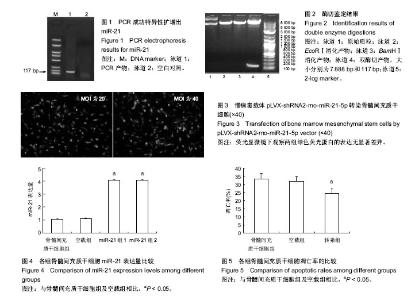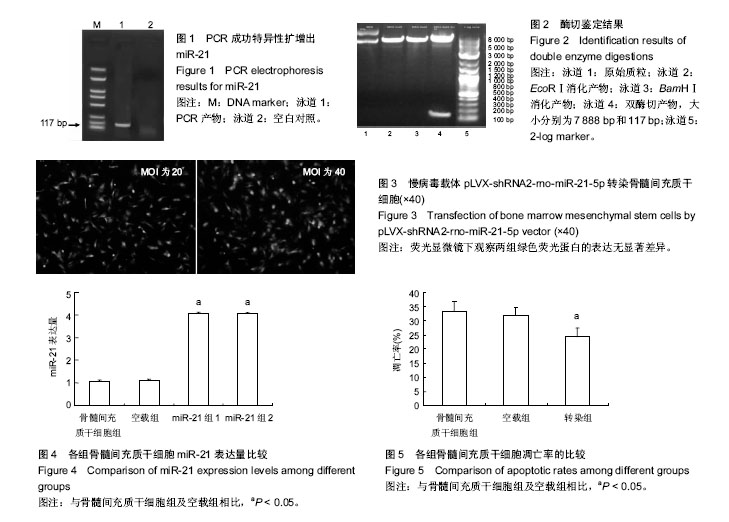| [1] Bianco P. "Mesenchymal" stem cells. Annu Rev Cell Dev Biol. 2014;30:677-704.[2] Glavaski-Joksimovic A, Bohn MC. Mesenchymal stem cells and neuroregeneration in Parkinson's disease. Exp Neurol. 2013;247:25-38.[3] Mathiasen AB, Qayyum AA, Jørgensen E, et al. Bone marrow-derived mesenchymal stromal cell treatment in patients with severe ischaemic heart failure: a randomized placebo-controlled trial (MSC-HF trial). Eur Heart J. 2015; 36(27):1744-1753.[4] Fu X, He Y, Xie C, et al. Bone marrow mesenchymal stem cell transplantation improves ovarian function and structure in rats with chemotherapy-induced ovarian damage. Cytotherapy. 2008;10(4):353-363.[5] 林楚伟,周胜华,戴海鹰,等.骨髓间充质干细胞移植大鼠梗死心肌后的存活状况[J].中国组织工程研究,2014,18(41):6628-6632.[6] Amiel J, de Pontual L, Henrion-Caude A. miRNA, development and disease. Adv Genet. 2012;80:1-36.[7] Dalmay T. Mechanism of miRNA-mediated repression of mRNA translation. Essays Biochem. 2013;54:29-38.[8] Mezzanzanica D, Canevari S, Cecco LD, et al. miRNA control of apoptotic programs: focus on ovarian cancer. Expert Rev Mol Diagn. 2011;11(3):277-286.[9] Virant-Klun I, Ståhlberg A, Kubista M, et al. MicroRNAs: From Female Fertility, Germ Cells, and Stem Cells to Cancer in Humans. Stem Cells Int. 2016;2016:3984937.[10] Ren J, Zhu D, Liu M, et al. Downregulation of miR-21 modulates Ras expression to promote apoptosis and suppress invasion of Laryngeal squamous cell carcinoma. Eur J Cancer. 2010;46(18):3409-3416.[11] 熊兵红,马利,程勇,等. miR-21在大肠癌中的表达及其靶基因探讨[J].南京医科大学学报:自然科学版,2014,34(3):281-286.[12] Sandhir R, Gregory E, Berman NE. Differential response of miRNA-21 and its targets after traumatic brain injury in aging mice. Neurochem Int. 2014;78:117-121.[13] 张薇,赵志英,张坤.慢病毒载体及应用研究进展[J].包头医学院学报,2011,27(5):107-109.[14] 赵铁军,倪伟海,郑有芳,等. 慢病毒载体及其介导的RNA干扰在基因治疗中的应用研究[J]. 浙江师范大学学报:自然科学版, 2014,37(2):206-211.[15] 景黎君,贾永林,鲁晶晶,等. MicroRNA-9-1慢病毒载体的构建及其对小鼠骨髓间质干细胞诱导分化为神经细胞的影响[J]. 中国病理生理杂志,2011,27(2):326-331.[16] Ma WJ, Lv GD, Tuersun A, et al. Role of microRNA-21 and effect on PTEN in Kazakh's esophageal squamous cell carcinoma. Mol Biol Rep. 2011;38(5):3253-3260.[17] 方国强,吴炳礼,李恩民,等. miR-21与肿瘤[J]. 癌变•畸变•突变,2010,22(1):65-70.[18] Si ML, Zhu S, Wu H, et al. miR-21-mediated tumor growth. Oncogene. 2007;26(19):2799-2803.[19] Asangani IA, Rasheed SA, Nikolova DA, et al. MicroRNA-21 (miR-21) post-transcriptionally downregulates tumor suppressor Pdcd4 and stimulates invasion, intravasation and metastasis in colorectal cancer. Oncogene. 2008;27(15): 2128-2136.[20] 毛颖佳,郑源强,石艳春. 慢病毒载体及其应用的研究进展[J]. 中国生物制品学杂志,2009,28(2):196-200.[21] Wu T, Liu Y, Fan Z, et al. miR-21 Modulates the Immunoregulatory Function of Bone Marrow Mesenchymal Stem Cells Through the PTEN/Akt/TGF-β1 Pathway. Stem Cells. 2015;33(11):3281-3290.[22] Xiong B, Cheng Y, Ma L, et al. MiR-21 regulates biological behavior through the PTEN/PI-3 K/Akt signaling pathway in human colorectal cancer cells. Int J Oncol. 2013;42(1): 219-228. |

